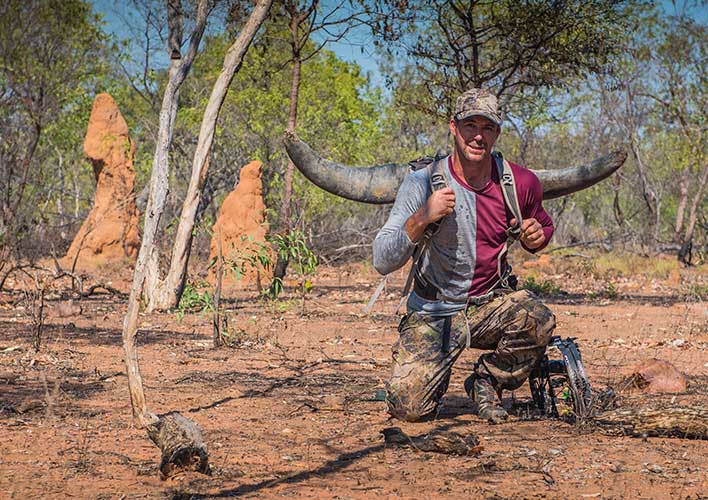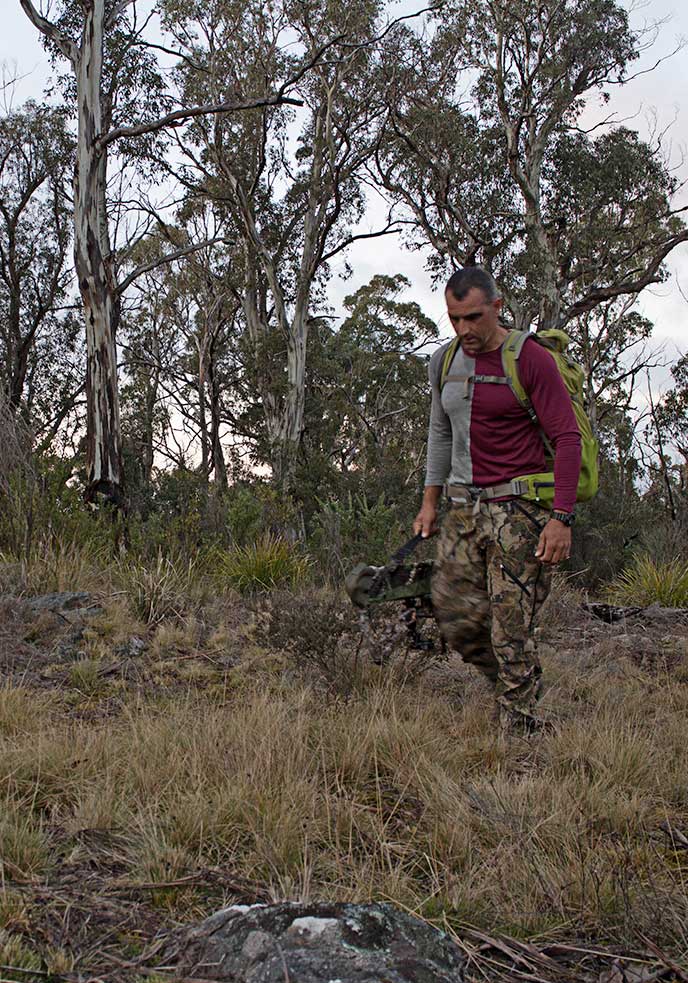The base layer is an important consideration to the hunter who wants to maximise the performance of their layering system. The moisture management capabilities of a well-performing base layer cannot be overstated. Over the years there have been various fibres and fabrics used to produce base layer products. Synthetic fabrics have enjoyed dominance in the past; in recent years natural fibres (namely merino wool) have gained massive popularity amongst hunters.
Camps remain divided between those that prefer natural and synthetic, and rightly so, both fabrics exhibit properties that make them very suitable for hunting applications.
In order to directly compare the positive and negative aspects of these fabrics, we have been trailing them both in real-world hunting conditions. This was achieved using specially made prototype base layer upper body garments. These were constructed in a manner to incorporate both the natural and synthetic fabrics and have utilised a “harlequin” half top design. That is, the garments were separated down the middle; with one side of the base layer being constructed using natural (merino wool) fabric, while the other side was made up purely using synthetic (polyester) material. This has given the field user the unique ability to make real-time comparisons while wearing the prototype by comparing the differences felt between their left and right sides.

While this concept of testing has been performed before, most field test studies comparing natural and synthetic fabrics have been for specific activities that involve continuous activity (bushwalking, running, etc). While hunting, by its very nature can also involve a period of high exertion (backpacking, climbing, carrying out meat, etc), it can also incorporate periods of very low exertion (glassing, tree stand, blind hunting). Sometimes both high and low exertion activities can be combined in a single hunt (climb and glass, spot and stalk).
It is this combined active and static nature of hunting that places additional requirements on the base layer garment when used for this application. Through this field test, we have aimed to gain insight into what materials are considered optimal for differing environments, climates, and levels of exertion.
Our field tests have involved approximately 30 participants using the prototype “half tops” within varied climates and environments during actual hunting use, the field test was run for a 3 month period.




While these field trials have given us important insight into the subjective qualities of the test fabrics, we also decided to counter this information by performing dedicated objective testing, then compare both subjective and objective test results in order to try and determine a more accurate common ground.
Objective testing has been performed in the state of the art textile facility located within the Royal Melbourne Institute of Technology Brunswick campus located in Melbourne, Australia. This was carried out over a four-semester period and conducted by Mandy Tingay, while being overseen by Mrs. Inna Konopov and Mr. Mac Ferguson.
Awesome work!!
Looking forward to hearing about the result. Can’t wait to see the product in your line up
Thanks Claye, we discovered some interesting things during the testing phase. We’ll be sharing some of these findings shortly.
Very keen to hear the reaults too! I’ve actually been searching around for some new base layer gear.
We used the insight gained from these tests to develop baselayers, they are coming shortly.
Nice!!! Will definitely be keeping an eye out for them.
Also, any idea when new stock of the schist pants in M/R are going to be available?
At this stage we are looking to have more Schist pants available for next season.
Ok..wow, long way away.
How soon for the results/new products to come out that reflect the study?
This study was completed some time ago, we will be posting up further updates. Production baselayers will be available in a few weeks. Thanks for your interest.
I would say merino has just been a more popular preference?
Yes you would think so, however that was not necessarily what this field trial revealed amongst the test participants.
I’ll participate if you want Simone with skin issues…?
*Someone
Thanks mate, but trials are completed. Base layers are coming based off our research, testing, and field trials.
Yeah nah I thought that was the case, I would be interested in knowing if any of the testers had any form of skin condition and what they preferred. Sounds gross but I have a form of tinea on my torso that causes me to itch badly and discolours my skin in a blotched effect especially in times of high exertion so again I’m interested if there’s any feedback.
None of the field testers suffered any skin conditions that we were aware of. Do you find your skin reacting when you wear merino next to skin?
Well that’s what I don’t know @tusxhunter I’ve never worn it on the directly to the upper body, only on my legs and no problem.
It’s hard to know for sure how you may react, though we will have multiple options coming so it’s likely we will have you covered. We will have more information coming shortly.
Some serious testers in those featured pictures
Yes, that’s true though it’s just a small sample of field testers that participated in the study.
So tusx undies and socks next?
Actually, we do have boxer shorts underwear coming.
Nice looking forward to the end result
The testing and research is now complete, production baselayers are coming shortly.
Awesome. I need to get the wife to up my allowance and wait on some XL summer pants. Early Christmas for me
LOL, you better be on your best behaviour in that case… 🙂
Me never. I’m always in trouble, I’m the 4th child. Haha. 3 daughters someone needs to make up for lack of sons
LOL 🙂
I’ll find a way need to add more camo to my collection, retiring my military camo for more technical hunting clothing and stuff that’s gonna last me on a thru hike next year too.
We do have many new styles coming and are committed to continually growing our product range.
Fantastic real world testing! I keenly await the results
Thanks Wayde, yes is was a long test. Field tests were approximately 3 months, lab tests were almost 1 year, then over 1 year in developing the actual production line. A long journey but we’re glad to have these baselayers coming shortly.
Still wearing mine.
Thanks for participating in the field test Marty. I think you will find the production baselayers are a big step up compared to the merino / polyester half tops your trialed.
So keen to see the results and whats in store.
We have used the findings from these trials to develop base layer products. More information will be coming.
I know of no other clothing company that puts this much into testing their own gear. Hats off to you once again mate.
Thanks Jay, we’re committed to finding the best solutions to assist with success in the field. While these projects are truly time-consuming, we feel they are worthwhile and necessary.